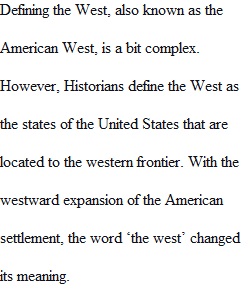


Q Instructions For this assignment you will provide a definition of what we are studying this session: the West. When defining the term, you should consider the following aspects of the term: chronology, demography, geography, and culture: that is, how understandings of what constitutes the West have changed over time; how the West has been defined in terms of the people inhabiting it; the specific regions that constitute the West; and the cultural traits that have been ascribed to the West. The paper should be at least two full pages of original text in length. Outside sources are not necessarily required, but any assertions presented in the paper as facts need to be supported by evidence. Similarly, passive voice should not be used when discussing things like the culture of the West--the paper should not state things such as "The West is associated with independence"; it needs to identify who associates it with independence and show evidence to support the assertion. The paper should use Chicago format, including 12-pt Times New Roman font and one-inch margins on all sides. The paper should be submitted as a .docx file The paper will be graded according to the following rubric: A: The paper is two full pages of original text in length and is free from grammatical errors and errors in formatting. The paper provides a detailed definition of the West, addressing chronology, demography, geography, and culture. All assertions in the paper are backed by evidence. Any sources used are fully and properly cited. B: The paper is two full pages of original text in length and might have some minor grammatical errors or errors in formatting. The paper provides a definition of the West with some detail, addressing chronology, demography, geography, and culture. Most assertions in the paper are backed by evidence. Any sources used are fully and properly cited. C: The paper is nearly two full pages of original text in length and might have some minor grammatical errors or errors in formatting. The paper provides a definition of the West with some detail, and addresses at least three of the four components of the definition (chronology, demography, geography, and culture). Most assertions in the paper are backed by evidence. Any sources used are fully and properly cited. D: The paper is below two full pages of original text in length and might have significant grammatical errors or errors in formatting. The paper provides a definition of the West but the definition lacks details, or addresses only two of the four components of the definition (chronology, demography, geography, and culture). The paper's assertions are generally not backed by evidence. Not all sources used for the paper are fully and properly cited. F: The paper is one page or less of original text in length and might have significant grammatical errors or errors in formatting. The paper provides a definition of the West but the definition lacks details, or addresses only one of the four components of the definition (chronology, demography, geography, and culture). The paper's assertions are not backed by evidence. The paper does not cite its sources or includes passages copied from sources without proper attribution
View Related Questions